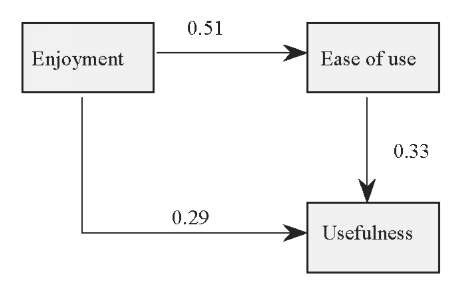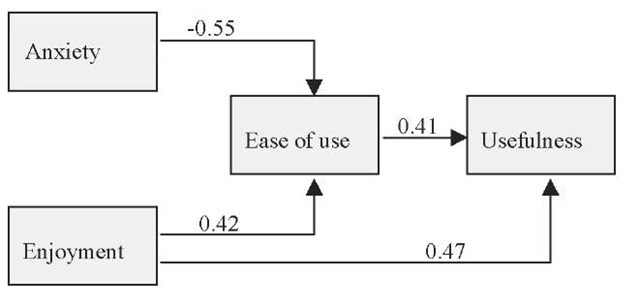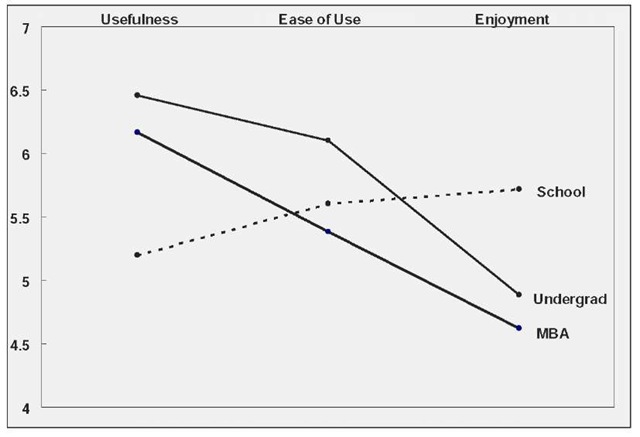INTRODUCTION
Information technology implementation is an intervention we make in order to improve the effectiveness and efficiency of a sociotechnical system. Using microcomputers to help individuals perform their jobs and tasks is one of the most important actions we take when implementing this technology effectively. Information systems effectiveness has been extensively studied using, mainly, user satisfaction and quality of information constructs to evaluate users’ acceptability (Iivari & Ervasti, 1994; Ives et al., 1983; Neumann & Segev, 1979). However, sometimes, the result of this intervention is not successful and may even generate difficulties related to people participation in the process. This leaves us with a question: What motivates individuals to use microcomputer technology in their daily activities?
Theorists and empirical researchers have been trying to understand the relevant motivators for the implementation and use of computer technology based on the idea that people make an effort if an activity is enjoyable or offers external rewards (Igbaria et al., 1996; Schwartz, 1983). They have been aiming to find out how individuals feel motivated to work with computers, and what motivates them to use computers in their daily activities.
BACKGROUND
Computer and information technology usage is determined by intrinsic as well as extrinsic motivation (Deci, 1975; Igbaria et al., 1996). The main driving forces considered in the literature as motivators for computer and information technology adoption are perceived usefulness, perceived ease of use, and perceived enjoyment (Davis, 1986, 1989; Igbaria et al., 1996). However, it is known that some individuals create personal obstructions to using technology (Pirsig, 1981), particularly, microcomputer technology (Igbaria & Parasuraman, 1989; Martocchio, 1994). They resist microcomputers usage and experience anxiety when they have to deal with them. We present results found in previous studies for relations and comparisons among the motivational forces above (Dias, 1998a, 1998b, 2002; Dias et al., 2002).
MAIN MOTIVATIONAL FORCES
Figure 1 shows the results for the relationships among perceived enjoyment, perceived ease of use, and perceived usefulness found in Dias (1998a). The author focused on the motivators perceived usefulness, perceived ease of use, and perceived enjoyment. The aim was to find out how Brazilian operations managers felt about using computer technology in their workplaces, how the perceived usefulness of computers is affected by ease of use and users’ enjoyment in working with them, and how to find opportunities to act according to this acquired knowledge, in order to increase the quality of microcomputer technology usage in organizations. In his study, the author emphasized the relationships among these perceived motivators for using microcomputer technology. The impact of the motivators on systems usage or microcomputer adoption was considered to be beyond the scope of his research.
The path analysis model used was based on the natural precedence of intrinsic motivational factors over extrinsic motivational factors, as proposed by the Freudian theory of psychoanalysis (Freud, 1976).
The data for that study were gathered using a questionnaire administered personally to 79 Executive MBA students at a Brazilian university. Respondents held managerial positions in 55 companies, ranging from small firms to large corporations, located in Rio de Janeiro. The average age of respondents was 36, and they had an average of 11 years working experience. All of the participants were college graduates. Managers said they used microcomputer technology mainly because they perceived it as a useful tool to increase the quality of their work, to accomplish tasks more quickly, and to increase the productivity of their jobs.
Figure 2 shows results of a model in which computer anxiety and enjoyment were considered as antecedent variables to ease of use and usefulness (Dias, 1998b). We found that managers who were more anxious about computer technology tended to find it more difficult to use. On the other hand, enjoyment had a positive direct effect on ease of use and usefulness, as stated before.
In a study made at a private university located in Rio de Janeiro, with data gathered from 336 undergraduate computer information systems students, Dias et al. (2002) tested the influence of some antecedent variables on enjoyment, ease of use, and usefulness. They found that (a) the fact that a student worked part-time in an area related to information technology positively influenced his or her perception of how easy it was to use microcomputers; (b) enjoyment with microcomputers seemed to decrease as students attained seniority in the university; and (c) older students perceived greater usefulness for microcomputers.
Figure 1. Relationships among enjoyment, ease of use, and usefulness
Figure 2. Anxiety and enjoyment as antecedent variables
Figure 3. Motivation level for graduate, undergraduate, and elementary school students
Level of education and age have shown influence on microcomputer attitudes (Igbaria & Parasuraman, 1989). Dias (2002) did a study on the motivation for using microcomputers among different classes ofusers. He aimed at finding out how graduate, undergraduate, and elementary school students, which represent very specific strata of educational level and age, would differ on the motivational factors examined here. The data for his study were gathered as follows:
• Fifty-three Executive MBA students of a leading Brazilian public university: The average age of respondents was 36, and they had an average of 11 years working experience, all participants were managers and had a college degree.
• Forty-six students aiming for degrees in Business Administration at a private university located in Rio de Janeiro: The average age of respondents was 22.
• Thirty-nine elementary schools students enrolled in the fourth to eighth grades of private (82%) and public schools located in the city of Rio de Janeiro: The students used microcomputers regularly at school, at home, or at relatives’ homes.
Factor analysis confirmed that the statements for usefulness, ease of use, and enjoyment constituted three distinct perception constructs for the three classes of users. It confirmed the existence of three factors that accounted for 63.5% of the total variance in the 138 interviewees.
Figure 3 shows the motivational profile for graduate, undergraduate, and elementary school students on the usage of microcomputers.
Table 1. Actions for successful implementation of microcomputers
| Action | Motivational Forces |
| Develop friendly systems
Encourage user participation in systems development Implement intensive user training Sell the system to users Facilitate access to microcomputers Respond to user needs Use up-to-date technology Align business and information technology |
Ease of use/enjoyment Usefulness/ease of use Ease of use Usefulness Ease of use Usefulness
Usefulness/enjoyment Usefulness |
Dias (2002) found that there was a statistically significant difference in the perceived enjoyment, perceived ease of use, and perceived usefulness of using microcomputers among MBA, undergraduate, and elementary school students. MBA and undergraduate students were most motivated by microcomputer technology usefulness. Elementary schools students mostly enjoyed the play aspect of microcomputers.
We did a study with managers in order to better understand these motivational forces and to generate recommendations for increasing the motivation for using microcomputers. Thirty-six managers were split into six working groups and asked to (1) discuss their experience in using microcomputers in their organizations (taking into account personal resistances for using computers in the workplace), situations in which this technology is used compulsively, motivators they thought were important for using computers for task execution, and organizational culture; and (2) propose actions they thought should be taken in the implementation of microcomputers in their workplaces that would lead to a more effective usage of this technology.
The main actions suggested and the corresponding motivational forces are presented in Table 1. We found that in order to attract adult users, information systems should be friendlier, use up-to-date interfaces, and be developed with user participation. In addition, it is important to offer intensive user training, to market the new systems to users heavily, and to fully meet the users’ needs in the specification of the systems.
Although managers showed less unanimity on the motivating power of enjoying themselves while using microcomputers, this motivation factor clearly showed its significance. Enjoyment seems to serve more as self-motivation, while usefulness seems to be linked to a feeling of duty—something that the organization expects managers to do or to attain.
FUTURE TRENDS
According to the World Summit on the Information Society (WSIS, 2003):
The global Information Society is evolving at breakneck speed. The accelerating convergence between telecommunications, broadcasting multimedia and information and communication technologies is driving new products and services, as well as ways of conducting business and commerce. At the same time, commercial, social andprofessional opportunities are exploding as new markets open to competition and foreign investment and participation. The modern world is undergoing a fundamental transforma -tion as the Industrial Society that marked the 20th century rapidly gives way to the Information Society of the 21st century. This dynamic process promises a fundamental change in all aspects of our lives, including knowledge dissemination, social interaction, economic and business practices, political engagement, media, education, health, leisure and entertainment. We are indeed in the midst of a revolution, perhaps the greatest that humanity has ever experienced.
Several new concepts lay the foundation for prospering in the next form of information and communication technology. The future microcomputer usage will be based upon ubiquity, universality, uniqueness, and unison (Watson et al., 2002). The keys to managing network-driven firms will be based on this notion of ubiquitous networks. In addition, we have to consider the new generation of students entering business schools around the world. These students are quite different from the students of the last decades, and we have to consider the technological, social, and cultural changes that are developing. The implications for the next- generation organization and information systems based on the Internet and mobile microcomputer technology have to be considered, and the motivational forces discussed here will probably have to be readdressed.
CONCLUSION
The research described here on motivation for using microcomputers offers several contributions for theory and practice. It confirmed that there are three positively interrelated motivators for computer technology usage: perceived usefulness, perceived ease of use, and perceived enj oyment. It also found that perceiving microcomputers as easy to use is negatively related to people’s anxiety toward using them.
The research also compared the perceived reasons for using microcomputers among different classes of users and showed that there are significant differences in the motivation for using them among graduate, undergraduate, and elementary school students. Elementary school students have greater enjoyment in using microcomputers than MBA and undergraduate students in Business Administration. MBA and undergraduate students in Business Administration perceive greater usefulness in the usage of microcomputers than elementary school students, and they said that they used microcomputers mainly because this increased the quality of their work and allowed them to accomplish tasks more easily and quickly. Undergraduate students in BusinessAdministra-tion think it is easier to use microcomputers than do MBA and elementary school students. MBA students think it is most difficult to use microcomputers in their daily tasks.
We should emphasize that the motivational forces studied here could not apply equally to different countries, cultures, or organizational environments. A study made by Straub et al. (1997) compared the technology acceptance model (TAM) (Davis, 1986) across three different countries: Japan, Switzerland, and the United States. The study was conducted by administering the same instrument to employees of three different airlines, all of whom had access to the same computer technology innovation—e-mail. They used perceived ease of use and perceived usefulness as independent variables. The results indicated that the model holds both for the United States and Switzerland, but not for Japan, suggesting that the model may not predict motivation for technology use across all cultures. Harris and Davidson (1999) examined microcomputer anxiety and involvement of groups of microcomputer-using students in six developing countries: China, Hong Kong, Malaysia, New Zealand, Tanzania, and Thailand. Differences in computer anxiety were found to exist between some of the groups, which were probably attributable to demographic factors. Differences were found to exist between the microcomputer involvements of some of the groups, which could be attributed to cultural factors.
KEY TERMS
Computer Anxiety: Degree to which an individual is nervous in his or her interaction with computers; the uneasiness some people feel when they have to use a microcomputer. Anxiety results from a danger or a danger threat. As a feeling, it has a clearly unpleasant character.
Computer Self-efficacy: A judgment of one’s capability to use a computer. It incorporates judgments of an individual on his or her skills to perform tasks using a microcomputer.
Extrinsic Motivation: Motivation that derives from what you obtain from engaging in an activity. An example of extrinsic motivation for using microcomputers is using it because you think it is useful for your job.
Intrinsic Motivation: Motivation that derives from the activity itself. An example of intrinsic motivation for using microcomputers is using it because you enjoy it.
Microcomputers Ease of Use: User perception on how simple and easy it is to understand and use microcomputers; degree to which an individual believes that using a particular computer system would be free of physical or mental effort.
Microcomputers Enjoyment: The extent to which the activity of using microcomputers is perceived as being enjoyable in its own right, apart from any performance consequences. It encompasses the feelings of joy, elation, or pleasure associated by an individual to a particular act.
Microcomputers Usefulness: The degree to which an individual believes that using a particular computer system would enhance his or her job performance.
Sociotechnical System: One that focuses on the interaction between the technical and social subsystems that exists in any work situation. As there is always a social system operating along with any technological system, we need to jointly design these two interrelated systems to get the best results from any work system.



